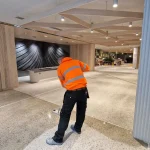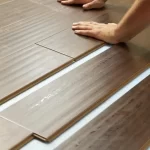
Let’s be honest. Decorating a small space can feel like a puzzle. You’re constantly balancing function, style, and that ever-elusive feeling of… space. And honestly, the foundation of it all—literally—is your floor. Get this choice right, and your entire studio or one-bedroom apartment can feel brighter, bigger, and infinitely more ‘you’.
Here’s the deal: the right flooring does more than just look good. It guides the eye, defines zones, and creates an illusion of square footage you didn’t know you had. So, let’s dive into the best flooring options to make your compact home feel anything but.
The Golden Rule: Go Light and Continuous
Think of a small room like a canvas. A light-colored, continuous floor acts like a blank slate, reflecting light and creating a seamless flow that makes boundaries seem to disappear. Dark, choppy floors, on the other hand, can visually box a room in.
That said… rules are made to be broken, sometimes. We’ll get to that.
Top Contenders: The Best Flooring for Small Spaces
1. Luxury Vinyl Plank (LVP) & Tile (LVT)
This is, hands down, the modern-day champion for apartments. Why? It’s a chameleon. LVP can mimic the look of light oak, weathered maple, or even pale stone with stunning realism. It’s durable, waterproof (a lifesaver for spills or that over-enthusiastic plant), and relatively easy to install, often as a floating floor.
Why it works for small spaces: You get the visual expansion of light wood or stone without the high cost or maintenance. The long plank format also helps draw the eye across the room, enhancing the sense of length.
2. Laminate Flooring
Laminate is LVP’s cousin, offering a similar click-lock installation and a huge range of styles. It’s generally less expensive and can handle a lot of foot traffic. The key is to choose a laminate with a low-gloss finish and minimal repeating patterns to keep things looking sophisticated, not synthetic.
Why it works for small spaces: It’s an affordable way to achieve that light, continuous wood look. Just be mindful of moisture—it’s not as waterproof as quality LVP.
3. Large-Format Porcelain Tile
If you’re going for a sleek, modern, or Mediterranean vibe, large tiles are your friend. Think 24×24 inches or even larger. The fewer grout lines you have, the less visual clutter and segmentation, which makes the floor—and thus the room—feel more expansive.
Why it works for small spaces: A light-colored, large-format tile in a matte or honed finish reflects light beautifully and creates a clean, unbroken surface. It’s also incredibly durable and cool underfoot, perfect for sun-drenched studios.
4. Polished Concrete
Okay, this one is a bit more niche, often found in lofts or newer builds. But if you have it, lean into it! Polished concrete is seamless, industrial-chic, and reflects light like no other material. You can even have it stained a lighter shade.
Why it works for small spaces: The ultimate in continuity. It literally turns your entire floor into one reflective surface, blurring the lines between different areas. It’s the epitome of an open-plan feel.
What About Carpet? A Cozy Caveat
Conventional wisdom says to avoid carpet in small spaces because it absorbs light and can feel heavy. And, well, that’s often true. But. If your studio apartment feels a bit sterile or you crave a specific kind of comfort, a very light-colored, low-pile, wall-to-wall carpet can work wonders.
It creates a soft, uniform base that can make a room feel like a cozy cocoon. The trick is to keep it light (think pale grey, beige, or even a very soft oat color) and the pile short. This maintains that sense of airiness while adding acoustic benefits and warmth.
The Power of Layout and Direction
It’s not just the material—it’s how you lay it. This is a pro-tip that makes a huge difference.
Installing planks or tiles parallel to the longest wall in your space will instantly make the room feel longer and more narrow. Conversely, laying them across the short width can make a very narrow room feel wider. It’s an optical illusion, but a powerful one. For a truly expansive feel, run the flooring in a continuous direction from the entryway straight through to the living and sleeping areas.
Zoning Without Walls: Creative Flooring Tricks
In a studio, you don’t have walls to separate your ‘rooms’. Your flooring can do that job.
- The Rug-as-Room Strategy: This is the easiest fix. A large area rug can instantly define your living area. A different one under the dining set creates a separate “dining room.” It adds texture and color without the permanence of changing the actual floor.
- A Bold (but Calculated) Contrast: Remember that “continuous floor” rule? You can break it—intelligently. Using a different, perhaps darker, tile in the kitchenette or entryway can create a subtle, stylish boundary. The key is to keep the main living area in the light, expansive material.
- Pattern Play: Using a patterned tile, like a classic cement tile, in a small entryway or bathroom can give that zone a distinct personality without overwhelming the entire space. It’s like a welcome mat built into the floor.
A Quick Comparison Table
| Flooring Type | Best For Small Spaces Because… | Something to Watch For |
|---|---|---|
| Light-Toned LVP/LVT | Waterproof, durable, realistic wood/stone looks, easy installation. | Can feel less “warm” underfoot than real wood. |
| Large-Format Tile | Minimal grout lines, highly reflective, ultra-durable. | Can be hard and cold; dropped dishes are a tragedy. |
| Light Low-Pile Carpet | Adds warmth & sound absorption; creates a cozy, unified feel. | Shows stains more easily; not ideal for allergy sufferers. |
| Polished Concrete | The ultimate seamless, modern, light-reflecting surface. | Can be expensive to install; not exactly “cozy.” |
A Final Thought: It’s Your Foundation
Choosing flooring for a small space is less about following rigid rules and more about understanding the tools of perception. Light, continuous floors open things up. Clever zoning creates order. And sometimes, breaking a rule with a dark, plush rug under your bed is exactly what makes a studio feel like home.
Your floor is the foundation of your daily life. In a small apartment, it becomes the stage. So choose a stage that makes you feel like you have all the room in the world to perform.










